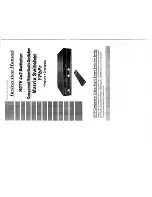
Avaya P333R User’s Guide
227
Appendix A
Embedded Web Manager
The Embedded Web Manager provides the following:
•
Device Configuration - Viewing and modifying the different device configurations.
•
Virtual LANs - Viewing and editing Virtual LAN information.
•
Link Aggregation Groups (LAGs) - Viewing and editing LAG information.
•
Software Redundancy - Setting software redundancy for ports in an Avaya P330
Switch.
•
Port Mirroring - Setting up port mirroring for ports in an Avaya P330 Switch.
•
Trap Managers Configuration - Viewing and modifying the Trap Managers
Table.
•
Switch Connected Addresses - View devices connected to selected ports.
•
IP Multicast filtering with IGMP snooping (new hardware)
— Software support from s/w 3.0.
— Hardware support - from Hardware Ver. C/S 2.0.
•
Port Security.
•
Intermodule Redundancy
— One pair per stack.
— Also operates as a result of a module fault, e.g., power failure.
•
Routing Manager - Viewing configurations of IP Routing protocols and general
information.
System Requirements
Minimum hardware and Operating System requirements are:
•
One of the following operating systems:
— Windows® 95
— Windows 98 SP1
— Windows 98 OSR (Second Edition)
— Windows ME
— Windows NT® Workstation or Server
— Windows 2000 Professional or Server
•
Pentium® II 400 Mhz-based computer with 256 Mb of RAM
(512 Mb recommended)
•
Minimum screen resolution of 1024 x 768 pixels
•
Sun Microsystems Java™ plug-in version 1.2.2 (supplied)
Summary of Contents for P333R
Page 1: ...Avaya User s Guide AVAYA P333R STACKABLE 3RD LAYER SWITCH SOFTWARE VERSION 3 11 July 2002 ...
Page 2: ......
Page 16: ...Table of Contents xiv Avaya P333R User s Guide ...
Page 18: ...List of Figures xvi Avaya P333R User s Guide ...
Page 20: ...List of Tables xviii Avaya P333R User s Guide ...
Page 54: ...Chapter 4 CLI Architecture Access Conventions 34 P333R User s Guide ...
Page 246: ...Chapter 7 Cajun Campus CLI Layer 3 226 Avaya P333R User s Guide ...
Page 266: ...Appendix B Specifications 246 Avaya P333R User s Guide ...
















































